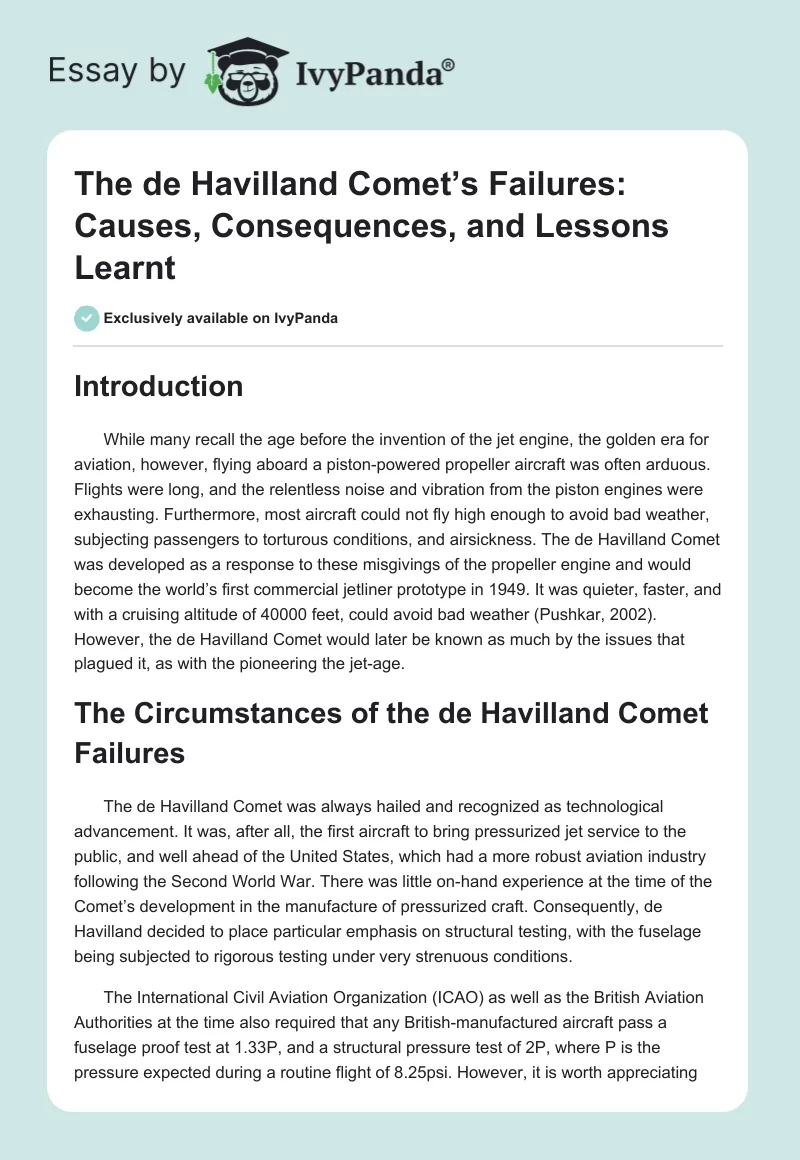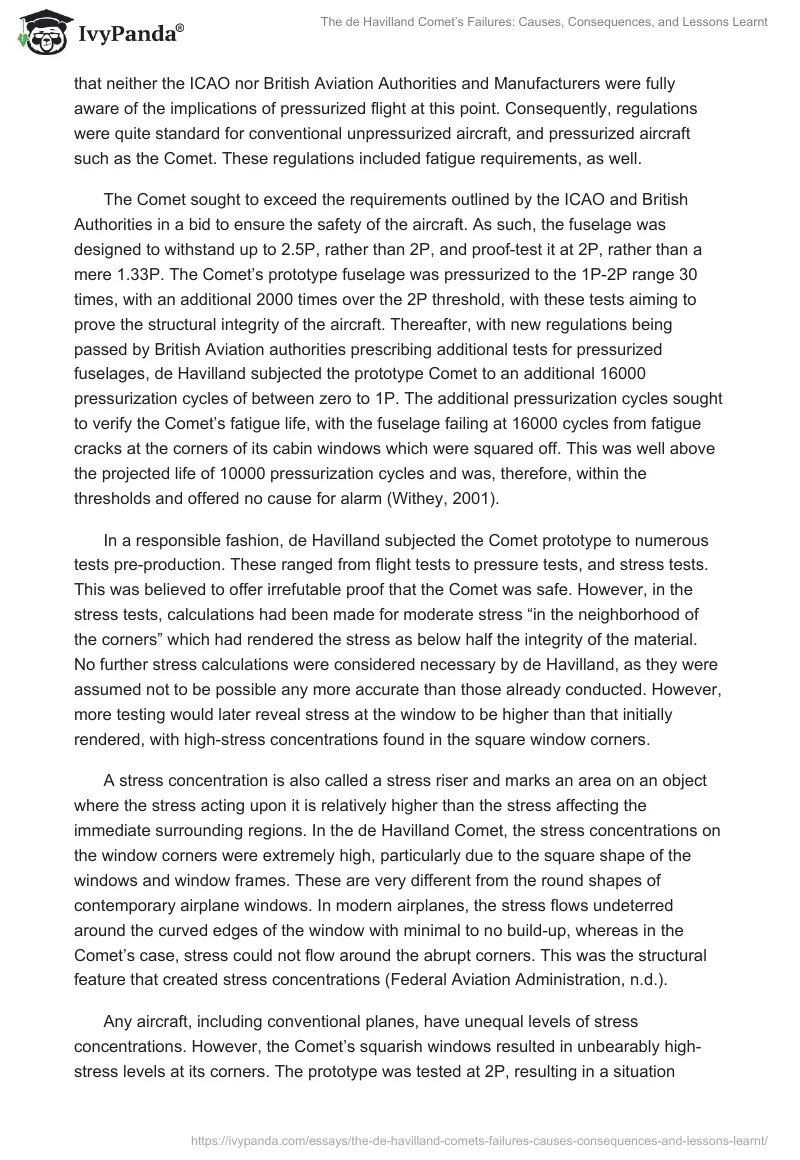Introduction
While many recall the age before the invention of the jet engine, the golden era for aviation, however, flying aboard a piston-powered propeller aircraft was often arduous. Flights were long, and the relentless noise and vibration from the piston engines were exhausting. Furthermore, most aircraft could not fly high enough to avoid bad weather, subjecting passengers to torturous conditions, and airsickness. The de Havilland Comet was developed as a response to these misgivings of the propeller engine and would become the world’s first commercial jetliner prototype in 1949. It was quieter, faster, and with a cruising altitude of 40000 feet, could avoid bad weather (Pushkar, 2002). However, the de Havilland Comet would later be known as much by the issues that plagued it, as with the pioneering the jet-age.
The Circumstances of the de Havilland Comet Failures
The de Havilland Comet was always hailed and recognized as technological advancement. It was, after all, the first aircraft to bring pressurized jet service to the public, and well ahead of the United States, which had a more robust aviation industry following the Second World War. There was little on-hand experience at the time of the Comet’s development in the manufacture of pressurized craft. Consequently, de Havilland decided to place particular emphasis on structural testing, with the fuselage being subjected to rigorous testing under very strenuous conditions.
The International Civil Aviation Organization (ICAO) as well as the British Aviation Authorities at the time also required that any British-manufactured aircraft pass a fuselage proof test at 1.33P, and a structural pressure test of 2P, where P is the pressure expected during a routine flight of 8.25psi. However, it is worth appreciating that neither the ICAO nor British Aviation Authorities and Manufacturers were fully aware of the implications of pressurized flight at this point. Consequently, regulations were quite standard for conventional unpressurized aircraft, and pressurized aircraft such as the Comet. These regulations included fatigue requirements, as well.
The Comet sought to exceed the requirements outlined by the ICAO and British Authorities in a bid to ensure the safety of the aircraft. As such, the fuselage was designed to withstand up to 2.5P, rather than 2P, and proof-test it at 2P, rather than a mere 1.33P. The Comet’s prototype fuselage was pressurized to the 1P-2P range 30 times, with an additional 2000 times over the 2P threshold, with these tests aiming to prove the structural integrity of the aircraft. Thereafter, with new regulations being passed by British Aviation authorities prescribing additional tests for pressurized fuselages, de Havilland subjected the prototype Comet to an additional 16000 pressurization cycles of between zero to 1P. The additional pressurization cycles sought to verify the Comet’s fatigue life, with the fuselage failing at 16000 cycles from fatigue cracks at the corners of its cabin windows which were squared off. This was well above the projected life of 10000 pressurization cycles and was, therefore, within the thresholds and offered no cause for alarm (Withey, 2001).
In a responsible fashion, de Havilland subjected the Comet prototype to numerous tests pre-production. These ranged from flight tests to pressure tests, and stress tests. This was believed to offer irrefutable proof that the Comet was safe. However, in the stress tests, calculations had been made for moderate stress “in the neighborhood of the corners” which had rendered the stress as below half the integrity of the material. No further stress calculations were considered necessary by de Havilland, as they were assumed not to be possible any more accurate than those already conducted. However, more testing would later reveal stress at the window to be higher than that initially rendered, with high-stress concentrations found in the square window corners.
A stress concentration is also called a stress riser and marks an area on an object where the stress acting upon it is relatively higher than the stress affecting the immediate surrounding regions. In the de Havilland Comet, the stress concentrations on the window corners were extremely high, particularly due to the square shape of the windows and window frames. These are very different from the round shapes of contemporary airplane windows. In modern airplanes, the stress flows undeterred around the curved edges of the window with minimal to no build-up, whereas in the Comet’s case, stress could not flow around the abrupt corners. This was the structural feature that created stress concentrations (Federal Aviation Administration, n.d.).
Any aircraft, including conventional planes, have unequal levels of stress concentrations. However, the Comet’s squarish windows resulted in unbearably high-stress levels at its corners. The prototype was tested at 2P, resulting in a situation where the pressure load combined with the stress concentrations on the squarish window corners. This resulted in the creation of stress levels considerable enough to warp the fundamental material characteristics at these specific sections of the fuselage. The material further changed with every time de Havilland increased the pressure load and eventually, these sections were of different material characteristics that a production de Havilland Comet. This phenomenon, in which material characteristics change under undue stress is referred to as cold-working (Withey, 2001).
It is also worth noting that despite cold-working in itself not being a safety issue, the misstep in de Havilland’s part was deciding to perform the fatigue tests on the same prototype fuselage that had undergone the pressure tests and had, consequently, cold-worked. This particular prototype withstood 16000 pressure cycles before failure, primarily due to the cold-worked material at the window corners. This cold-working immensely improved the fatigue properties of the fuselage at these locations, which unfortunately hid the true fatigue vulnerability of the production Comet fuselage (Withey, 2001; Federal Aviation Administration, n.d.).
Of the Comets that infamously crashed, they had not undergone the proof-tests at 2P and, therefore, did not bear the benefits of cold-worked window corners to improve their fatigue capabilities. In the flights of the production Comets, the window corners’ were subjected to very similar stress levels and stress concentrations which significantly fatigued the materials and hand such a tremendous effect on the production fuselages that, instead of the projected 10000 to 16000 cycles of fatigue life posted by the prototype cold-worked Comet, the production Comets were only reaching about 1000 cycles. At the expiry of their fatigue lives, the worn-out materials ruptured catastrophically, resulting in a horrific inflight breakup. Due to the previous cold-working in the prototype Comet, the results did not reflect the accurate fatigue characteristics of a production aircraft (Darling, 2001).
Precursors and Consequences of the de Havilland Comet Failures
The de Havilland DH-106 Comet 1 made its maiden flight on May 2, 1952, which made it the world’s first pressurized civilian jet transport. As such, the Comet was in many ways, a technological marvel, and pioneered the way for the development of the jet-engine era. However, due to the Comet being a novel technology, there were no particular precursor events. There were so many unknown variables regarding stress and fatigue in pressurized flight, despite the fundamental physics being quite reviewed and understood. The Comet failures themselves became the unfortunate precursor events for future study into the fatigue incidences that occurred later (Federal Aviation Administration, n.d.; Withey, 2001).
Shortly after the inaugural flight of the de Havilland Comet, other manufacturers and jets made their debuts. These included the Boeing 707, the Tupolev Tu104, and the Sud Aviation Caravelle. In 1954, following several grisly and highly publicized failures, the Airworthiness Certificate for the de Havilland Comet was revoked, which created a void that other manufacturers sought to fill in the pressurized jet airplane market.
The de Havilland Comet design had adopted a general structural design paradigm that was referred to as the “safe-life” design philosophy. With this approach, critical parts on the aircraft were awarded a safe amount of time, a number of cycles, or a length in-flight hours where they were expected to function within normal or acceptable parameters. This was, in the case of the de Havilland Comet, determined via extensive designing, evaluation, and testing. It was determined, therefore, that the Comet’s safe life was 10000 cycles, after which replacements and repairs could be implemented to render the aircraft safe for another calculated number of life cycles (Withey, 2001).
As a result of the failures of the de Havilland Comet, Boeing and other pressurized aircraft manufacturers designed their airplanes, such as the Boeing 707, under a structural design philosophy of “fail-safe”. In this design paradigm, each critical part designed had redundancies, alternative load paths, and provisions for failures and weaknesses in the event that they occurred. This resulted in heavier, more complex designs which were, however, arguably safer less more intensive to manufacture. In more contemporary jet designs, manufacturers have largely adopted an evolved version of these two structural design philosophies termed as the “Damage tolerant” approach. In this design paradigm, attributes of both the “safe-life” approach and the “fail-safe” approach are integrated into one objective standard. The Damage tolerant structural design philosophy involves the capability that provides reasonably safe operation within specific failure and damage thresholds between regular inspection intervals (Withey, 2001).
Conclusion
Only a limited number of Comet 1s were produced and delivered before the model was revamped enough to be assigned a new designation. The Comet 1A featured an increased fuselage strength and other necessary safety redundancies. However, the model that saw the squarish window changed to a more conventional round shape was the Comet 1XB. This was perhaps the most iconic and structurally significant re-design that modern engineering has done to prevent the re-occurrence of the Comet’s failures, along with reinforced fuselages. The Comet proved that the squarish window corners were sources of stress concentrations; a phenomenon fixed by contemporary aircraft designs with round windows. Further, the de Havilland Comet, and other related accidents that occurred owing to metal fatigue of pressurized fuselages, however, offered up some invaluable lessons.
The primary one undoubtedly would be that maintenance and other aircraft service programs should ideally be predicated on a comprehensive understanding of the fatigue and stress properties of a plane’s complex structural elements. Further, test specimens and prototypes of an aircraft must be exposed to highly similar conditions as the production airplane. This would better ensure that the performance of the prototype is highly indicative of the performance of the production units, preventing the re-occurrence of the de Havilland Comet situation whereby the prototype results were far too conservative of the production units expected usage and environment.
Reference List
Withey, P. (2001). Fatigue failure of the de havilland comet i. In Failure Analysis Case Studies II (pp. 185-192). Pergamon.
Darling, K. (2001). De Havilland Comet. Specialty Press Publishers and Wholesalers.
Pushkar R. (2002). Comet’s Tale.
Federal Aviation Administration. (n.d.). de Havilland DH-106 Comet 1. Web.


